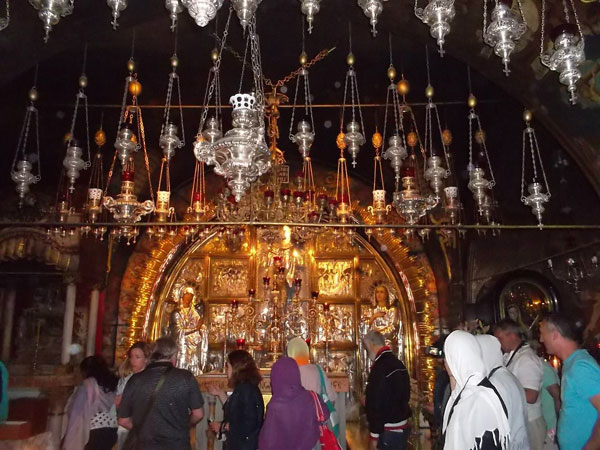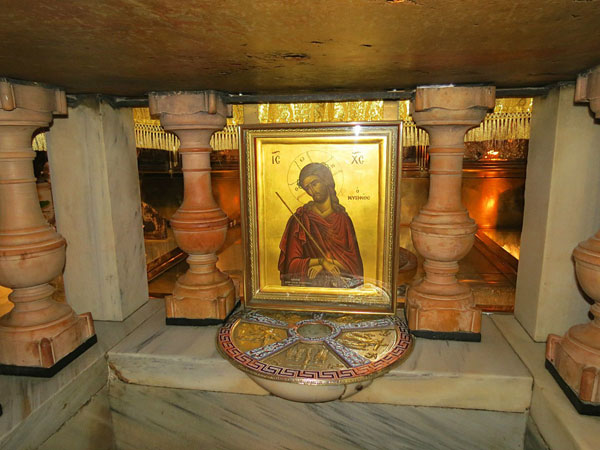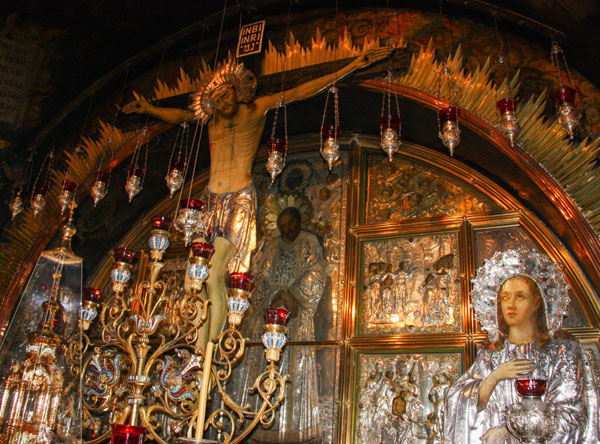Calvary, Golgotha, and also Gagulta (Aramaic: ܓܓܘܠܬܐ), was, according to the Gospels, a site immediately outside Jerusalem's walls where Jesus was said to have been crucified. Golgotha(s) (Greek: Γολγοθᾶς) is the Greek transcription in the New Testament of the Aramaic term Gagultâ. The Bible translates the term to mean place of [the] skull, which in Greek is Κρανίου Τόπος (Kraníou Tópos), and in Latin is Calvariæ Locus, from which the English word Calvary is derived.
Golgotha is referred to in early writings as a hill resembling a skullcap located very near to a gate into Jerusalem: "A spot there is called Golgotha, – of old the fathers' earlier tongue thus called its name, 'The skull-pan of a head'."
Since the 6th century it has been referred to as the location of a mountain, and as a small hill since 333. The Gospels describe it as a place near enough to the city that those coming in and out could read the inscription "Jesus of Nazareth – King of the Jews". When the King James Version was written, the translators used an anglicized version – Calvary – of the Latin gloss from the Vulgate (Calvariæ), to refer to Golgotha in the Gospel of Luke, rather than translate it; subsequent uses of Calvary stem from this single translation decision. The location itself is mentioned in all four canonical Gospels:
Mark: And they brought him to the place called Gol'gotha (which means the place of a skull).
Matthew: And when they came to a place called Gol'gotha (which means the place of a skull).
Luke: And when they came to the place which is called The Skull, there they crucified him, and the criminals, one on the right and one on the left.
John: So they took Jesus, and he went out, bearing his own cross, to the place called the place of a skull, which is called in Hebrew Gol'gotha.
In the Douay-Rheims Version (a Roman Catholic English translation of the Bible), Luke 23:33 reads:
And when they were come to the place which is called Calvary, they crucified him there; and the robbers, one on the right hand, and the other on the left.
The "place of a skull" (Aramaic: gagûltâ ܓܓܘܠܬܐ) etymology is based on the Hebrew verbal root גלל g-l-l, from which the Hebrew word for skull, גֻּלְגֹּלֶת (gulgōleṯ),[9] is derived. A number of alternative explanations have been given for the name. It has been suggested that the Aramaic name is actually Gol Goatha, meaning mount of execution, possibly the same location as the Goatha mentioned in a Book of Jeremiah passage,[10] describing the geography of Jerusalem.[3] An alternative explanation is that the location was a place of public execution, and the name refers to abandoned skulls that would be found there,[3] or that the location was near a cemetery, and the name refers to the bones buried there.
In some Christian and Jewish traditions, the name Golgotha refers to the location of the skull of Adam.[3] A common version states that Shem and Melchizedek traveled to the resting place of Noah's Ark, retrieved the body of Adam from it, and were led by Angels to Golgotha – described as a skull-shaped hill at the centre of the Earth, where also the serpent's head had been crushed following the fall of man. This tradition appears in numerous older sources, including the Kitab al-Magall, the Conflict of Adam and Eve with Satan, the Cave of Treasures, and the writings of Patriarch Eutychius of Alexandria. It is also suggested that the location's landscape resembled the shape of a skull, and gained its name for that reason.












